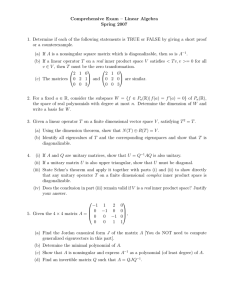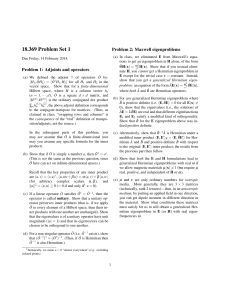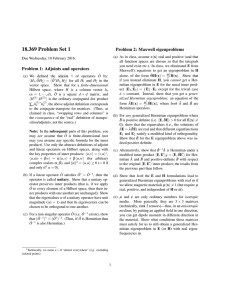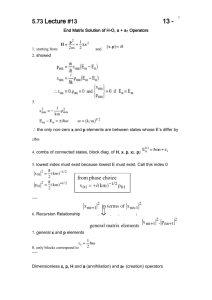Document 10507939
advertisement
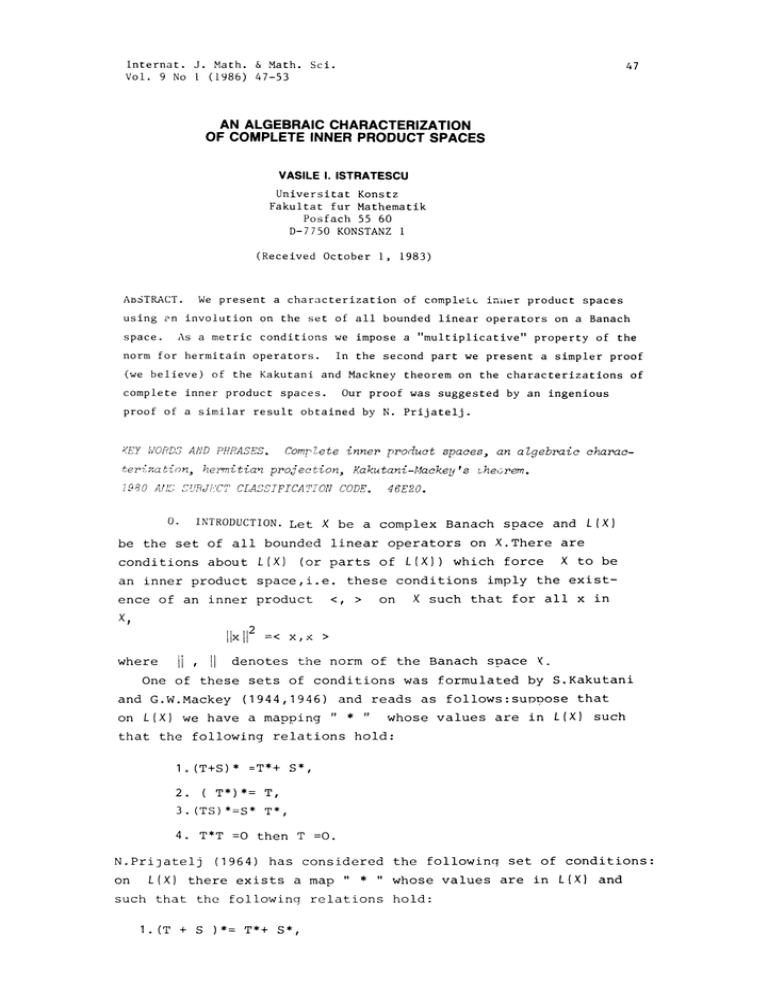
Internat. J. Math. & Math Sci.
(1986) 47-53
47
Vol. 9 No
AN ALGEBRAIC CHARACTERIZATION
OF COMPLETE INNER PRODUCT SPACES
VASILE I. ISTRATESCU
Universitat Konstz
Fakultat fur Mathematik
Posfach 55 60
D-7750 KONSTANZ
(Received October i, 1983)
ABSTRACT.
We present a characterization of complete inn=r product spaces
using en involution on the set of all bounded linear operators on a Banach
space.
As a metric conditions we impose a "multiplicative" property of the
In the second part we present a simpler proof
norm for hermitain operators.
(we believe) of the Kakutani and Mackney theorem on the characterizations of
Our proof was suggested by an ingenious
complete inner product spaces.
proof of a similar result obtained by N. Prijatelj.
EY WORDS AND PHRASES.
Comylete inner product spaces, an algebraic characterization, hermitian projection, Kakutani-Mackey ’s heorem.
7980 ATL’ SUBJ{!CT CLASSIFICATION CODE. 46E20.
0.
INTRODUCTION. Let X be a complex Banach space and L (X)
be the set of all bounded linear operators on X.There are
conditions about [(X) (or parts of i(X)) which force X to be
an inner product space,i.e,
,
<, >
ence of an inner product
IIll
where
I
li
-<
,
these conditions imply the existon
X such that for all x
>
denotes the norm of the Banach space
in
.
One of these sets of conditions was formulated by S.Kakutani
and G.W.Mackey (1944,1946) and reads as follows:suDpose that
on i(X) we have a mapping
whose values are in i(X)
*
such
that the following relations hold:
(T+S)* =T*+ S*
T*)*= T,
2.
3
(TS)*=S* T*
4. T*T =O then T =O.
N.Pri3atelj
on
(1964) has considered the followinq set of conditions:
[() there exists a map
*
whose values are in [()
such that the followinq relations hold:
(T + S )*: T*+ S*
and
V. I. ISTRATESCU
48
2. (T )
3. (TS)
T,
=
ST
,
In what follows we
present
a new set of conditions on [(XI which
imply the existence of an inner product on
X
<, > satisfying
the relation
and which simplifies to some extent the conditions imposed by
N.Prijatelj.
Further we present a new proof of the Kakutani-Mackey theorem
which we believe to be simpler than the original one. Our proof
is inspired from the proof in the Prijatelj’s paper.
I.
AN ALGEBRAIC CHARACTERIZATION OF COMPLETE INNER PRODUCT SPACES.
be the set of all
Let X be a complex Banach space and i(X)
bounded linear operators on
X.
Theorem 1.1.Suppose that on [(X) there exists a mapping
’’
with values in i(X)such that the following conditions are
satisfied:
I. (T+S)
2. (T)
=
=
T*+ S
T,
,
,
3.
(TS)= ST
4
if P is a hermitian rojection (i e
-
p2
Then on X there exists an inner product space
property that
llxll
=P =P) then
<,>
with the
--< x,x >o
Proof.Let us consider a,b be two arbitrary linearly independent
which generate a (closed)subspace of X,which we
elements in
X
denote by
2.
We consider an element f in X which has the followin pronerties:
I.
f(a)=llall
2.
Ilfll =.
Using f we deine the ollowing operator
Pl x=
f (x) /
by the formula:
llall.a.
It is not difficult to see that this operator is a hermitian projection.
Now since
b=P1b+ (I-PI) b
ALGEBRAIC CHARACTERIZATION OF COMPLETE INNER PRODUCT SPACES
49
we get that (l-P1)b #o (since a,b are supposed linearly independent).
We choose g in
with the properties:
2.
IIiI :.
We consider the following operator on X:
P2x=g(x)/ll(I-Pl)bll (l-P1)b.
This is a hermitain projection and
we have the relations:
PIP2=P2 p1=O
which implies that the operator P defined by the formula
P
=PI +P2
is a hermitian projection on
X.From our condition we get that the
norm of P is 1.Then the Kakutani-Bohnenblust theorem
implies that
on the space X there exists an inner product satisfying the theorem.
Remark 1.2 Our conditions in the theorem 1.1 are much like to those
of Kakutani-Mackey and Prijatelj; the conditions I-3 are identical
while the condition 4
requires in fact that the Prijatelj’s
condition must be satisfied for hermitian operators which are
projections.
2.
A PROOF OF THE KAKUTANI-MACKEY’S THEOREM.
In what follows we present a proof of the Kakutani-Mackey’s
using some ideas from the proof of N.Prijatelj’s elegant
paper. In order to make the Note selfcontained we give here more
theorem
details.
Let us consider an element a # o of X and f in X
properties
with the following
2. f(a)=a
We consider on i(X) the following functional g defined by the
formula:
g (T)=f (Ta)
and it is clear that this is a positive functional (i.e.
g(I)=1=
).
Using this functional we define the following bilinear fo on
(we remark that the positivity of g implies that g(T)=(g(T)),
<T,S> =g (S" T)
which has all the properties of an inner product except the fact that
<T,T> =O does not necessarily implies that T=O.Suppose now that the
has the following additional property: for any u,v in
there exists a unitary operator U (i.e. U’U =UU’=I)
,}u
such that Uu=v.
algebra
=v
50
V. I. ISTRATESCU
We consider now an operator defined on i(X)with values in
which
is defined as follows:
W(T)=Ta.
IIWII =llall
Then it is clear that
and if N(W)
is the null
is a left ideal in i(XI.Another left ideal in
then N(W)
space of W
[(X) is
defined as follows:
R, R s [(X),<R,R> =o
=N.
Then clear we have the inclusion
N(W) cN
and we show that we have in fact an equality. Now since we suppose
that i(X)
has the additional property with respect to unitary
operators,we consider an arbitrary element x of X,x # o .Then we
find an unitary operator U with the property that
llxll
Since
u
is in [(X)
w(llxll
we get that
u) -x.
Now in order to prove the above equality
we must prove the inclusion
in the converse sense and for this it suffices to Drove that
CN (W)
C
c
Suppose that T is in
and then
CN(W)
o.
Ta =x
W(T)
We find
N
a unitary operator U in
[(X)
with the property that
fix flue
x
or
llxll
Ta
Ua
which gives that
ilxll
(TThis implies
U) a =o.
that
(T-
Now if T,S are in
llxll
U)
N(W)
=
N
[(X) and T-S is in N then
g (TT) =g (SS)
Further this means that
Ig(TT)-g (ss) I=Ig(T(T-S))+g((T-S) S)
and applying the
=<Ig(T’(S-S))l+Ig((T-S)’S)
Cauchy-Buniakowsky’s inequality (for positive
functionals) we get that
g (T (T-S)) =o
g((T-S) *s)=o.
Since
(T-
IIxll
u)
is in N we have that
-
.
ALGEBRAIC CHARACTERIZATION OF COMPLETE INNER PRODUCT SPACES
Thus if
*I -llxll u*llxll u -llxllu*u
x # o,g(TT) # o and thus we have that
the inclusion
N c N (W)
llxll
51
T is in C N which implies
and thus the equality follows.
i(X) /N(W) =[(X)/N and we remark
We form now the quotient space
to
that this is isomorphic
X,for each x in X the corresponding
element in
[(X)/N
is the equivalence class determined by the
condition W(T)=x.
Using this isomorphism we can define an inner product on X as
[x],[y] denotes the
follows: if x,y are arbitrary elements in and
corresponding elements in [(X)/N then we set
<x,y> =g(u v)
with u arbitrary in [x]and v arbitrary in
[
From the Cauchy-Buniakowsky’s inequality (for positive functionals)
we see immediately that < > is well defined in the sense that
it does not depend on u,v in the equivalence classes.
Of fundamental importance of the above inner product is the property
Indeed,suppose that
<x, x>
W(T)=Ilxll
="
and thus
II I
and the assertion follows.
theorem
In order to complete the proof of the Kakutani-Mackey’s
we must show that i(X)satisfies the additional property formulated above.
Let us consider a two-dimensional subspace of
the linearly independent elements e
without loss of generality that
and
(el,e 2)
e2.We
X generated by
may suppose
satisfies the following
properties
2.for some fixed f in X* ,f(e
Suppose now that x
generated by e
is an arbitrary element of
and e
2.
xisl.
Then
x=Ae
1)=l,f(e 2 )O.
+Be2
where A,B are scalars.
X 2 ,the subspace
We may suppose also that the norm of
V. I. ISTRATESCU
52
We must prove that there exists a unitary operator U with the
property that
Ue1=x.
Now ,every operator on X
/ a11
\ a21
renresented by a 2x2 matrix
2
a]2\
a22]
and the adjoint by the matrix
Since the property
holds the elements a.. are linear combi-
nations of the conjugate ,i.e.,
b kj"
{
aij
Further,since the properties 2 and 3 holds taking into account
that the identity operator is hermitian and that the operator
P1x=f(x)el
is hermitian and a projection as well as the fact that for
T,TT
any operator
is hermitian,we get that the coefficients
satisfy the following relations:
12
I=b11
+b2
o
11
=b12
11
+b2
22
=b22 +b 22
=b21 +b22
21
11
11
11
i=b1111 ’=b12
,o =b21
,o =b22,
21
12
21
12
21 =o
b11 =b12
12 =b11 =b11 =b22 =b22
11
21
21
=b
=r,r a real number,
12
12
12
-I
b
=r
21
b
Thus we have
a11=a11 ’a12=a21’a21=a12’a22=a22
(where the bar denotes the conjugate).
Now we use the fact that for unitary operators U the relations
must agrre again and thus the followinq relations must be hlod:
a1111 +r a2121 =I =a 1111 +r-1 a12a12
a1211 +r a2221 ==r a1121 +a12 22’
r
r
a
11
a
+a
12
a12a12
+
21
a
a22a22
22
=o
=I =r
a
21
a
11
+r -I
a22
a21 a21 +a22 a22.
12
ALGEBRAIC CHARACTERIZATION OF COMPLETE INNER PRODUCT SPACES
53
In this case we must have
=r(1-a4 a4 )=r
a22a22 =alla11 ’a12a12
(I-a4 a4
Thus if we set
a11
we have that
i (0-s+t)
a22
=-ae
a21
=((1-a
2
,a12
2
=( (1_a )r) I/2 e i (0+t)
I/2 e i (e-s)
)r-
s,t are neal numbers (parameters)
where
Thus the matrix representing a unitary operator has the form:
a e
i0
2
i
((1-a)r) I/2 e (e+s)\
i(8-s-t)
-a e
I/2 e i(8-t)
2
((1-a)r-
Now if x is an arbitrary element of
X
2
show that for some unitary operator U,U e
(of norm I) we must
=x.
This clear is equivalent with the relation
a e
el+
(1-a
2) I/2 ei(8-t)
=A
e1+B
e
=x.
2
Now if
B=a
A=ale
2
2
e
from
A/B
=(al/a2).e
i
(0 -8
=(1-a
2
2 I/2
a
-I e -it
we conclude that
81-82
=t,
a=(a/(a 2+a)
and thus
x=C(a e
i0 1.e
+(I -a
2 I/2
i(0 -8
2 .e
e
From the fact that the norm of x is
a2=(1-a 2) I/2oThUs
we conclude that a=a
the matrix of the unitary operator is
(I
A e
(I
2
A
2)I/2 e
i(8-t)
A
A e
I/2 e i (e+s)
i(+t-s)
2)
/
Thus the additional property holds for our algebra and this
completes the proof of the theorem.
REFERENCES
i.
KAKUTANI S. and MACKEY, G.W., Two characterization of real Hilbert spaces.
Ann. Math. 45 (1944) 50-58.
2.
KAKUTANI S., Ring and lattice characterizations of complex Hilbert spaces.
Bull. Amer. Math. Soc. 52 (1946) 727-733.
3.
PRIJATELJ, NIKO, AlgeFa characterizations of Hilbert spaces. Publications
of the Department of Mathematics, I. Ljubljana, 1964 pp43-57.
4.
ISTRATESCU, V.l., Inner product
structures.
Theory and applications.
Reidel Publ. Co. Dordrecht-Boston.
(To pper).
D.
